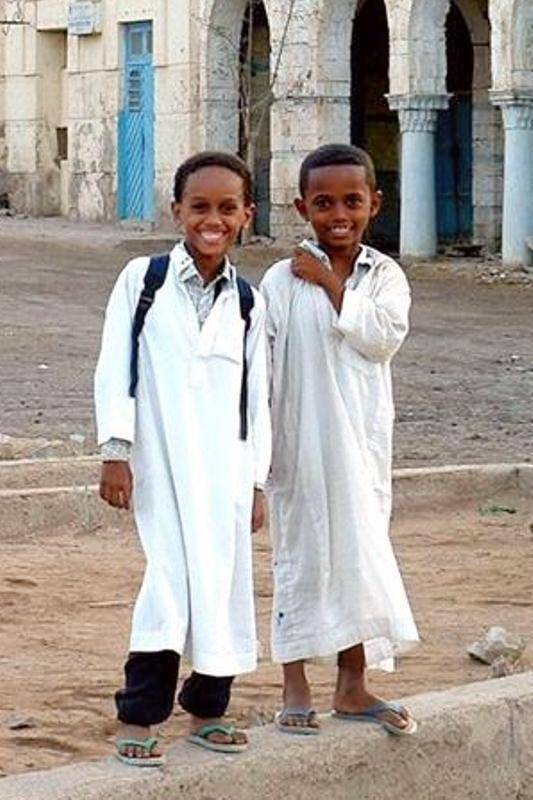
Eritrea: Education

Figure 1.--This photo was taken in Massawa, on the Red Sea coast of Eritrea. It shows two oys going to school. Both are wearing the traditional robe. The boy on the left side wears the robe with shirt and long trouserst, while the boy on the right side seems wearing the robe as the only clothing. both boys have flip-flops. Notice the one boy's back pack.
|
|
We know nothing about historic education in Eritrea at this time. Italy colonized much of what what is now Eritrea and Somalia in the late-19th century. They founded some schools, but we have few details. The British seized the Italian colonies during World War II and Eritra was annexed by Ethiopia. We have little information on schools during the Ethiopian period. After a long independence struggle, Eritrea gained its independence at the time of the fall of Ethiopia's Marxist Government. A Eritrean source reports on schools in modern Eritrea, "Education is well organized in Eritrea. Tuition is subsidized by the government and studies relevant to the development of Eritrea are their main focus. In the first 10 years of independence, Eritrea has invested heavily in education. School enrollment increased by 270 percent at the Elementary and middle levels and by 185 percent at high School level. Education starts at the age of five with 2 years for social interaction and adjustment of behavioral reaction. Thereafter follow 5 years of Elementary School at the age of 7 until grade 5, where the children learn to read and write, operations, mathematics, biography, geography, Eritrean history, singing, arts and sports. Primary education is followed by 2 years of middle School (grade 6 and 7) where the subjects mentioned above are deepened. Finally there is four years of Secondary School (grade 8 to 11) with the subjects physics, chemistry, biologics, history, geography, mathematics, English and civics."
Historic Education
We know nothing about historic education in Eritrea at this time. Like most countries in the wider-Arab world, education seems to have been very limited and largely focused on Islam.
Italian Colonial Era ( -1941)
Italy colonized much of what what is now Eritrea and Somalia in the late-19th century. They founded some schools, but we have few details. The first modern schools were built during the Italian colonia era, but we have few details on the colonial school system.
Ethiopian Era (1945-91)
The British seized the Italian colonies during World War II and Eritra was annexed by Ethiopia. We have little information on schools during the Ethiopian period. Ethiopia was apoor country with a very limited educatiinal system. Education was further impaired in Eritrea by the simmering war for independence which escalted in the 1980s in opposition to the Marrxist Gic=vernment which seized power un Ethiopia.
Independent Eritrea (1991- )
After a long independence struggle, Eritrea gained its independence at the time of the fall of Ethiopia's Marxist Government (1991). Eritrea at the time of independence was one of the poorest countries in the world with an extrodinarily high rate of illiteracy. Eritrea was a poor area before the war, but the long war damaged the already weak infrastructure and economy. Education was one of many areas that had deteriorated. The new government had very limited resources to address Eritrea's huge problems. Despite the limitations, the Givernment placed a significant emphasis on building an educational system, viryally from scratch.
An Eritrean source reports on schools in modern Eritrea, "Education is well organized in Eritrea. Tuition is subsidized by the government and studies relevant to the development of Eritrea are their main focus. In the first 10 years of independence, Eritrea has invested heavily in education. School enrollment increased by 270 percent at the Elementary and middle levels and by 185 percent at high School level. Education starts at the age of 5 with 2 years for social interaction and adjustment of behavioral reaction. Thereafter follow 5 years of Elementary School at the age of 7 until grade 5, where the children learn to read and write, operations, mathematics, biography, geography, Eritrean history, singing, arts and sports. Primary education is followed by 2 years of middle School (grade 6 and 7) where the subjects mentioned above are deepened. Finally there is four years of Secondary School (grade 8 to 11) with the subjects physics, chemistry, biologics, history, geography, mathematics, English and civics."
The average Eritrean child completes about 5 years of school, meaning essentially the primary school level. We are unsure as to differences in attendance levls among boys and girls.
HBC

Related Chronolgy Pages in the Boys' Historical Web Site
[The 1880s]
[The 1890s]
[The 1900s]
[The 1910s]
[The 1920s]
[The 1930s]
[The 1940s]
[The 1930s]
[The 1940s]
[The 1950s]
[The 1960s]
[The 1970s]
[The 1980s]
Related Style Pages in the Boys' Historical Web Site
[Long pants suits]
[Knicker suits]
[Short pants suits]
[Socks]
[Eton suits]
[Jacket and trousers]
[Blazer]
[School sandals]
[School smocks]
[Sailor suits]
[Pinafores]
[Long stockings]
Navigate the Boys' Historical Clothing Web Page
[Return to the Main Eritrean page]
[Return to the Main African school uniform country page]
[Introduction]
[Activities]
[Biographies]
[Chronology]
[Clothing styles]
[Countries]
[Bibliographies]
[Contributions]
[FAQs]
[Glossary]
[Images]
[Links]
[Registration]
[Tools]
[Boys' Clothing Home]
Created: 1:02 PM 6/8/2009
Last updated: 1:02 PM 6/8/2009




